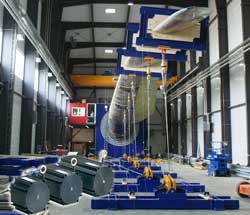
Posted to News on 9th Nov 2009, 16:44
Draw-wire sensors measure wind turbine blade deflection
Draw-wire displacement sensors from Micro-Epsilon are playing a vital role in the testing of the latest generation of wind turbine blades at the Fraunhofer Institute in Bremerhaven, Germany.

The Fraunhofer Institute in Bremerhaven, Germany, has a test rig that simulates the distortion of wind turbine rotor blades; the tip of the blade can be distorted by up to 10m due to mechanical loads, with the rig capable of testing rotor blades up to 70m long.
During tests, the rotor blade itself is mounted horizontally in the test rig. Steel cables are attached to the rotor using guide pulleys fixed to the rotor blade at various positions along its length, either directly or via mechanical clamps. Twelve draw-wire sensors from Micro-Epsilon measure the distortion.
Two draw-wire sensors for each cable are mounted to the rails on the floor. These sensors measure the movement and, therefore, the distortion of the rotor blade. The sensors are Micro-Epsilon's P115 wireSENSOR units that have measuring ranges of between 3m and 10m. The sensors operate with a digital output signal and are particularly robust due to their aluminium housing.
The principle of operation for a draw-wire ('string pot') displacement sensor is relatively straightforward, hence the inherent reliability of these devices. A draw-wire sensor works rather like a tape measure, except the user does not have to read off the measurement of the extended tape. The rotation of the drum on which the steel wire is wound is measured automatically. The drum incorporates a long-life spring drive that ensures the steel wire is rewound.
Chris Jones, Managing Director at Micro-Epsilon (UK), comments: "In addition to wind turbine testing, our draw-wire sensors are being used in a wide range of applications, from general industrial machinery and scissor lifts, through to more specific uses such as dentist chairs, patient lifting tables, theatre stages, pneumatic and hydraulic systems, aircraft landing gear and forklift trucks. Our wireSENSOR range is proving very popular with UK machine builders and OEMs who require low-cost, robust, reliable sensing solutions that can be easily integrated into their customer's existing machine, components or control and automation systems."
The wireSENSOR range uses three main measurement methods:
- Multi-turn potentiometer
- Incremental encoder
- Absolute encoder
One of these is mounted onto the drum axle, converting the rotary motion of the drum into a signal that can be evaluated. The measured displacement can be output as an analogue current, voltage or potentiometric signal. For a digital output there is a choice of HTL or TTL, with interfaces for most of the common fieldbus systems, including CANopen, SSI and Profibus.
As with traditional tape measures, the wireSENSOR series is capable of measuring around corners and edges. Micro-Epsilon supplies as accessories deflection pulleys to deflect the steel wire in the desired direction.
Follow the link for more information about Micro-Epsilon's range of draw-wire (string pot) sensors.
No. 1 Shorelines Building
Shore Road
CH41 1AU
UNITED KINGDOM
+44 (0)151 355 6070






























